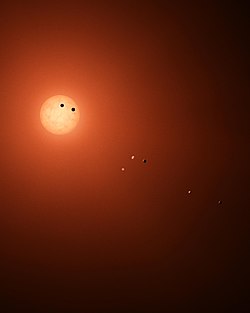Trappist-1
| 2MASS J23062928-0502285 | |
 Illustration av TRAPPIST-1 och de sju planeterna | |
| Observationsdata | |
|---|---|
| Stjärnbild | Vattumannen[1] |
| Rektascension | 23t 06m 29.283s[2] |
| Deklination | -05° 02′ 28.59″[2] |
| Astrometri | |
| Avstånd | 40[1] lå |
| Detaljer | |
| Massa | 0,08[1] M☉ |
| Luminositet | 0,05[1] L☉ |
| Andra beteckningar | |
| TRAPPIST-1[1], 2MASSI J2306292-050227, 2MASSW J2306292-050227, 2MUCD 12171[2] | |

TRAPPIST-1 (med katalognummer 2MASS J23062928-0502285) är en röd dvärg-stjärna[2] i vattumannens stjärnbild, belägen 40 ljusår från jorden.[1] Den har sju planeter, alla ungefär lika stora som jorden.[1] Omloppstiden för de sex innersta planeterna är mellan ett och ett halvt och 13 dygn, den sjunde och yttersta planetens egenskaper är än så länge ganska okända. 22 februari 2017 hade forskarna hittat ytterligare 4 planeter och systemet har totalt 7 jordliknande planeter. Det är sannolikt att åtminstone tre av planeterna har flytande vatten.[3] Från stjärnan och utåt benämns planeterna Trappist-1b, Trappist-1c, Trappist-1d, Trappist-1e, Trappist-1f, Trappist-1g, och Trappist-1h.
Namnet syftar på att planetsystemet upptäcktes med teleskopet Transiting Planets and Planetesimals Small Telescope (TRAPPIST) på La Silla-observatoriet i Chile. Upptäckten gjordes 2015 och 3 planeter påvisades då. Vid fortsatta observationer i infrarött med Spitzerteleskopet upptäcktes ytterligare 4 planeter 2017.

Referenser
- ^ [a b c d e f g] Tre potentiellt bebeoliga planeter hittade kring närliggande ultrasval stjärna, ESO, 2 maj 2016
- ^ [a b c d] 2MASS J23062928-0502285 på SIMBAD
- ^ ”Dvärgen och de sju planeterna ger livet god tid att utvecklas”. Dagens Nyheter. https://www.dn.se/arkiv/nyheter/dvargen-och-de-sju-planeterna-ger-livet-god-tid-att-utvecklas/. Läst 22 februari 2017.
Externa länkar
- TRAPPIST-1 (Site som underhålls av medlemmar i teamet som upptäckte objektet.)
Media som används på denna webbplats
This is Kepler’s view of the TRAPPIST-1 system, an ultra-cool red dwarf star with seven rocky planets, at least three of them believed to be temperate worlds.
This illustration shows the seven TRAPPIST-1 planets as they might look as viewed from Earth using a fictional, incredibly powerful telescope. The sizes and relative positions are correctly to scale: This is such a tiny planetary system that its sun, TRAPPIST-1, is not much bigger than our planet Jupiter, and all the planets are very close to the size of Earth. Their orbits all fall well within what, in our solar system, would be the orbital distance of our innermost planet, Mercury. With such small orbits, the TRAPPIST-1 planets complete a "year" in a matter of a few Earth days: 1.5 for the innermost planet, TRAPPIST-1b, and 20 for the outermost, TRAPPIST-1h.
This particular arrangement of planets with a double-transit reflect an actual configuration of the system during the 21 days of observations made by NASA's Spitzer Space Telescope in late 2016.
The system has been revealed through observations from NASA's Spitzer Space Telescope and the ground-based TRAPPIST (TRAnsiting Planets and PlanetesImals Small Telescope) telescope, as well as other ground-based observatories. The system was named for the TRAPPIST telescope.
NASA's Jet Propulsion Laboratory, Pasadena, California, manages the Spitzer Space Telescope mission for NASA's Science Mission Directorate, Washington. Science operations are conducted at the Spitzer Science Center at Caltech, also in Pasadena. Spacecraft operations are based at Lockheed Martin Space Systems Company, Littleton, Colorado. Data are archived at the Infrared Science Archive housed at Caltech/IPAC. Caltech manages JPL for NASA.
For more information about the Spitzer mission, visit http://www.nasa.gov/spitzer and http://spitzer.caltech.edu.This chart shows, on the top row, artist concepts of the seven planets of TRAPPIST-1 with their orbital periods, distances from their star, radii and masses as compared to those of Earth. On the bottom row, the same numbers are displayed for the bodies of our inner solar system: Mercury, Venus, Earth and Mars. The TRAPPIST-1 planets orbit their star extremely closely, with periods ranging from 1.5 to only about 20 days. This is much shorter than the period of Mercury, which orbits our sun in about 88 days.
The artist concepts show what the TRAPPIST-1 planetary system may look like, based on available data about their diameters, masses and distances from the host star. The system has been revealed through observations from NASA's Spitzer Space Telescope and the ground-based TRAPPIST (TRAnsiting Planets and PlanetesImals Small Telescope) telescope, as well as other ground-based observatories. The system was named for the TRAPPIST telescope.
The seven planets of TRAPPIST-1 are all Earth-sized and terrestrial, according to research published in 2017 in the journal Nature. TRAPPIST-1 is an ultra-cool dwarf star in the constellation Aquarius, and its planets orbit very close to it.
NASA's Jet Propulsion Laboratory, Pasadena, California, manages the Spitzer Space Telescope mission for NASA's Science Mission Directorate, Washington. Science operations are conducted at the Spitzer Science Center at Caltech, also in Pasadena. Spacecraft operations are based at Lockheed Martin Space Systems Company, Littleton, Colorado. Data are archived at the Infrared Science Archive housed at Caltech/IPAC. Caltech manages JPL for NASA.
For more information about the Spitzer mission, visit http://www.nasa.gov/spitzer and http://spitzer.caltech.edu.



